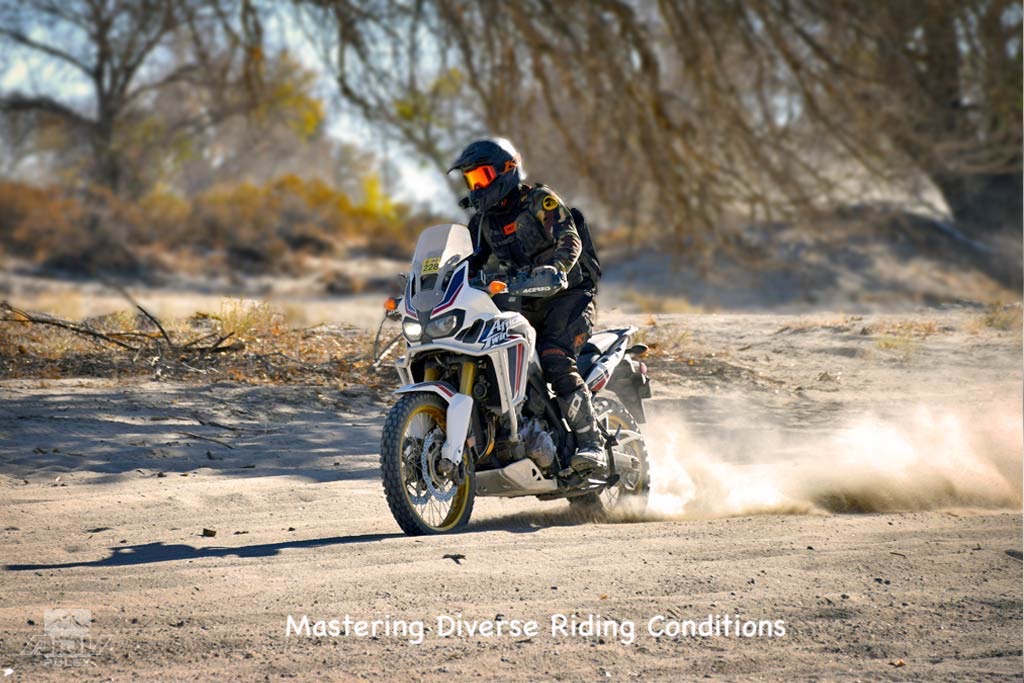
Riding a motorcycle is a thrilling experience that offers freedom and a unique connection to the open road. However, every seasoned rider knows that mastering diverse riding conditions is the key to becoming a truly skilled motorcyclist. In this blog post, we will explore the art of navigating various terrains, weather conditions, and situations, equipping you with the knowledge and confidence to handle any riding challenge that comes your way.
Riding a motorcycle comes with its unique set of challenges, especially when faced with varying weather conditions and terrains. This chapter will guide you through the art of riding in traffic, rain, snow, trails, off-road, sleet, hail, sand, hills, desert, cold weather, and hot weather, ensuring you're well-prepared for any riding scenario.
Riding in Traffic
Stay Visible: Wear high-visibility gear and utilize reflective strips on your motorcycle to increase your visibility to other motorists.
Lane Positioning: Choose the appropriate lane position to maximize visibility and maintain a safe distance from other vehicles.
Defensive Riding: Anticipate the actions of other drivers, avoid blind spots, and be ready to take evasive maneuvers if necessary.
Riding in Rain
Traction Management: Reduce your speed and increase the following distance to allow for longer braking distances. Be gentle with throttle and brake inputs to avoid skidding.
Rain Gear: Invest in waterproof riding gear to stay dry and comfortable. Ensure your helmet has a clear visor for optimal visibility.
Avoid Puddles: Puddles can hide potholes and road hazards. Try to ride around them when possible.
Riding in Snow
Tire Choice: Consider using snow-rated or winter tires for improved traction on icy roads.
Gentle Inputs: Use smooth throttle and brake inputs to prevent skidding. Leave ample room for braking.
Heated Gear: Invest in heated grips and clothing to stay warm in cold conditions.
Riding on Trails and Off-Road
Body Positioning: Stand on the footpegs for better control and balance when riding off-road. Keep your weight forward when ascending and backward when descending.
Tire Pressure: Adjust tire pressure to suit off-road conditions. Lower pressure provides better traction on loose terrain.
Learn Riding Techniques: Master techniques such as body weighting, controlled slides, and throttle modulation for off-road riding.
Riding in Sleet and Hail
Protective Gear: Full-face helmets and durable riding suits protect against sleet and hail.
Reduce Speed: Slow down and maintain a safe distance from vehicles to avoid hail-related damage.
Seek Shelter: If possible, find shelter during heavy hailstorms, as hail can be hazardous.
Riding in Sand
Tire Selection: Choose knobby or off-road tires to improve traction in the sand.
Maintain Momentum: Keep a consistent speed to stay on top of the sand rather than sinking in.
Avoid Sudden Movements: Smooth and gradual inputs are crucial in sandy terrain to prevent loss of control.
Riding on Hills
Body Positioning: Lean forward when ascending hills and backward when descending to maintain balance.
Use Lower Gears: Downshift to a lower gear for ascending steep hills to maintain power and control.
Brake Control: Use both brakes judiciously, and avoid excessive front brake use on steep descents.
Riding in the Desert
Hydration: Stay well-hydrated by carrying enough water, especially in desert environments where temperatures can soar.
Protective Gear: Wear lightweight but protective gear to shield yourself from the sun and abrasive desert terrain.
Sand Dunes: Approach dunes with caution, maintaining a steady throttle and an upright riding position.
Riding in Cold Weather
Layered Clothing: Dress in layers to trap warmth and manage temperature changes. Insulated gear is crucial.
Heated Gear: Invest in heated grips, vests, or gloves to combat cold temperatures.
Tire Traction: Cold weather can reduce tire grip, so ride cautiously and give yourself an extra stopping distance.
Riding in Hot Weather
Hydration: Carry ample water and take regular breaks to stay hydrated in scorching heat.
Ventilated Gear: Opt for well-ventilated riding gear to promote airflow and keep cool.
Watch for Signs of Heat Exhaustion: Be aware of heat-related symptoms and prioritize your safety.
Riding a motorcycle in diverse conditions and terrains requires adaptability and a commitment to safety. By mastering these techniques and tips, you'll be well-equipped to navigate various riding scenarios and enjoy the exhilaration of motorcycling while minimizing risks. Always prioritize safety and continuously hone your skills to become a more confident and capable rider.
Mastering diverse riding conditions on a motorcycle is a journey that requires practice, knowledge, and a commitment to safety. By following the tips and techniques outlined in this blog post, you can confidently tackle any challenges that Mother Nature or the road throws your way. So, gear up, stay informed, and embark on your next ride with the assurance of a true motorcycle enthusiast.